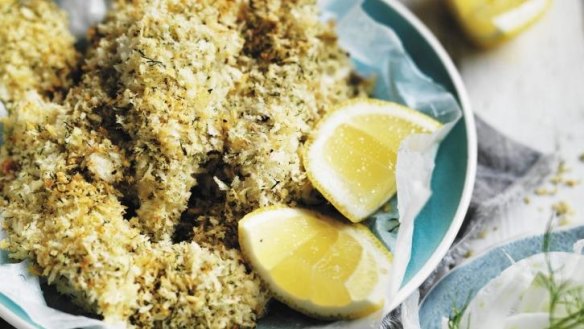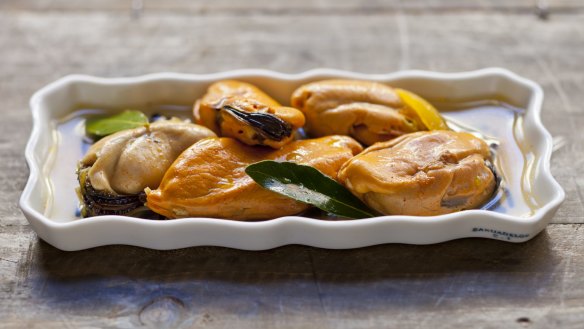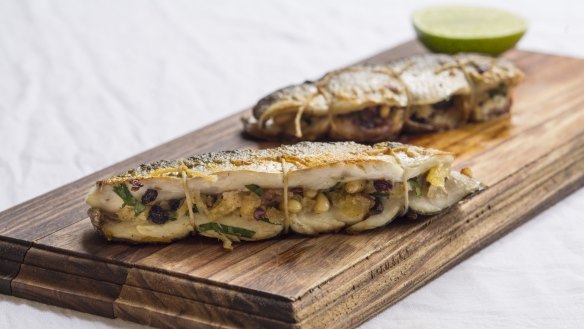Which fish is best? Most sustainable species for baking, frying, battering and barbecue

Oliver Edwards is a sous chef at Melbourne's Cumulus Inc restaurant and a co-author of sustainable Australian seafood website GoodFishBadFish. He recently completed a social science honours year, in which he studied Victoria's seafood markets.
Here are his tips for the best Australian species to choose for your next seafood dish, whether it be baked, fried, poached or steamed, battered or barbecued. There's even a good local choice to serve sashimi-style (raw). So go on, get cooking.
1. Baked whole fish
Bream: Bream is a popular fish to serve whole (whether baked, grilled, steamed or deep-fried), as they are plate-sized and the delicate sweet flesh retains its moisture when cooked on the bone.
How to bake bream: Trim the fins and dorsal spines off your whole fish with kitchen scissors, then make a couple of slashes on each side to help the heat penetrate all the way to the bone with ease. Season well on both sides as well as in the gut cavity, then place with a little oil in a hot baking dish and cook in a hot oven for approximately 15 minutes or until cooked through. A tasty and easy addition is to stuff the cavity with lemon and herbs.
Bream are similar in size, flavour and texture to baby snapper – which they are closely related to. Try any of the bream family, including species such as frypan bream, black bream, yellowfin bream or tarwhine.
2. Pan-fried
- Fried yellow-eye mullet with currants and pine nuts
- Fried and soused fish with saffron and onions
- Jill Dupleix's perfect salt 'n' pepper calamari
Mullet: Mullet are short-lived, fast-growing fish with robust stocks. They are also cheap and delicious, making them one of my favourite species for an easy dinner.
How to fry mullet: Pan-frying mullet with the skin on results in crisp skin and moist flesh. Use a medium heat, and fry skin-side down for three minutes. Flip and cook on the flesh side for 30 seconds to one minute to ensure that the flesh remains moist.
Note: If the fillets of mullet (or any other species for that matter) are sticking to the pan when you attempt to flip them, they're not ready. Leave them for another 30 seconds to one minute and they should come off cleanly and easily.
Southern calamari: For a quick pan-fry, try local calamari. The sweet, tender hoods and legs require minimal cooking at a high heat. Scoring the flesh will allow the heat to penetrate quicker, shortening cooking time and resulting in tender pieces with a pleasing curl. Pan-fried calamari can be added to salads, served by themselves or dropped at the last minute into soups or curries.
3. Poached (as in a soup of Thai-style curry)

Leatherjacket: Leatherjacket and the closely related ocean jacket have firm, white, lustrous flesh that becomes quite dense on cooking but remains moist. The meat holds its shape well when diced and used in curries or soups. Leatherjacket is generally bought as a skinless and headless "trunk". Depending on size you can choose to cook them filleted, or cut across the bone into large chunks.
Leatherjacket and ocean jacket are short-lived and productive species caught off south-east Australia, and their stocks are healthy.
Mussels: Mussels are a versatile and sustainable seafood option. All of the blue mussels that you can purchase in Australia have been farmed. Mussel farming not only has very little impact on surrounding environments, it can actually be beneficial. This is because mussels filter water, in doing so improving water quality to the benefit of the local marine environment.
How to cook mussels: Mussels are juicy and have a great "sea flavour". They take very little time to cook, so as soon as they open, remove them from the heat to prevent the meat from shrivelling and becoming tough and chewy. Mussels can be dropped into a soup or curry at the last moment of cooking and allowed to open. Alternatively, steam open briefly in a covered pan and then add to the soup or curry.
Note: The idea that mussels that don't open should be discarded is a myth. Simply prise open the shell to get to the meat – if it has gone bad you will be able to smell it distinctly.
4. Barbecue

- Grilled mackerel with cucumber and tomato salad
- Stuffed tomatoes with grilled kingfish (or mackerel or sardines)
- Blackened snapper (or mahi mahi)
Spanish mackerel: A firm, slightly oily fish such as Spanish mackerel is perfect for the barbecue. It will remain moist and hold together well even after being exposed to the hard, direct heat of a barbecue grill. Purchase a steak or "cutlet" (also known as a darne), oil and salt lightly, and then grill on a high heat for 2-3 minutes each side. Spanish Mackerel is a sustainable alternative to swordfish. Like swordfish, Spanish mackerel can dry-out if overcooked, so avoid this.
Also try: Mahi-mahi, which is a fast-growing, abundant species with similar cooking and tasting notes to Spanish mackerel. The charred flavours and smokiness provided by the barbecue method of cooking also work really well with oily-fleshed, stronger flavoured fish such as blue mackerel, Australian herring (tommy ruff) and Australian salmon. Cook skin-side down to protect the slightly soft flesh and enjoy the crisp, charred result. These fish, especially when barbecued, are best accompanied by other bold flavours – try tomato, garlic, capers, citrus, grilled vegetables and fresh herbs galore.
5. Raw/sashimi
Bonito: Fresh bonito tuna is fantastic raw, being similar to the more popular yellowfin, though slightly softer in texture. It is smooth, rich and light purple-red in colour. Raw bonito is well suited to Asian flavours such as light soy, ginger, wasabi and ponzu.
Also try: Very fresh whiting, snapper and flathead are also good raw, having clean-tasting flesh with a pleasant, almost "crunchy", texture when uncooked.
6. For making fish stock
Snapper bones: For a good fish stock you want a species with lots of gelatin in its bones, as this will create a beautifully flavoured stock with a good mouth-feel. Snapper heads, bones, fins and trimmings are great for this. They also have a nice clean flavour. Avoid using oily or dark-fleshed fish for stocks, and remove gills and any visible bloodline, both of which will cloud the stock and give you a "dirty" flavour.
How to make fish stock: Rinse the bones very well in cold water, then put them in a pot with some vegetables and aromatics and just cover with cold water. Bring up to a simmer, skimming any foamy scum that rises to the surface. You only want to cook a fish stock for around an hour or less – any longer and you risk dissolving calcium in the bones, which will give you a cloudy stock with a chalky taste. If you want a stronger flavoured fish stock, rather than leaving it on longer, I would recommend straining and discarding the bones, and then reducing the stock itself to the desired flavour and consistency.
Victorian snapper stocks are considered healthy, and the fishery is classified as "sustainable".
7. In batter - fish 'n' chips
- Healthy fish 'n' chips (use whiting)
- Neil Perry's crunchy (roasted) panko-coated king george whiting
- Dani Valent's best beer batter
Whiting: King george whiting and its lesser-known cousins sand whiting, grass whiting, trumpeter whiting and school whiting are all delicious served filleted, battered and deep-fried. The sweet and delicate flesh remains juicy as it steams inside it's protective batter coating, and the light flake contrasts beautifully with the crisp batter.
Whiting species school in coastal and estuarine environments throughout southern and eastern Australia, and are caught by a range of hand line and netting methods. Fish stocks are well monitored and considered sustainable by the relevant state and national bodies. A great choice and a GoodFishBadFish favourite.
Appears in these collections
The best recipes from Australia's leading chefs straight to your inbox.
Sign up